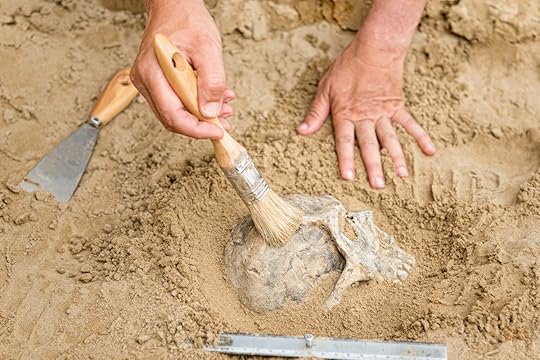Ripley Entertainment Inc.'s Blog, page 5
October 1, 2023
CARTOON 10-01-2023
September 30, 2023
CARTOON 09-30-2023
September 29, 2023
Human ‘Skull Cup’ Has Been Discovered In Spanish Cave
Featured in Ripley's Believe It or Not!

Archaeologists in Spain recently discovered prehistoric human bones buried thousands of years ago in a Spanish cave that were possibly tied to cannibalistic practices. Among the findings were a human shinbone, i.e., tibia, crafted into a tool and a human skull in the shape of a cup!
Spectacular FindsThis area in the southern part of Spain has produced other similar objects, indicating that there was a strong connection between the living and the dead.
Archaeologists from the University of Córdoba in Spain and University of Bern in Switzerland examined 12 ancient burial sites from Cueva de los Marmoles (CM). The site is about 45 miles southeast of Córdoba. Prehistoric humans lived in the cave over several different periods of time. Researchers analyzed the remains of seven adults and five children from the region’s Neolithic period to its Bronze age or 4000-1000 BCE.
A Bone-Chilling DiscoveryThe bones were examined under a microscope and appeared to have been purposely fractured. This could indicate that the marrow was drained and the flesh scraped and removed.
The shinbone was polished and pitted in such a way that it resembled a tool. The archaeologists, however, did not specify its exact purpose. The “skull cup” was made from a man aged 35 to 50. The researchers noted that the cranium had been deliberately separated from the lower skull and was scraped to clear away any flesh.

Image credit: Photographs by Z. Laffranchi, CT images by M. Milella.
This type of skull cup is not the first of its kind. Other Neolithic sites in the region have produced similar finds. It’s possible that prehistoric people used these objects to access the brain and eat it, but some of these cups have marks indicating they were used for consuming liquids.
We Can’t Know For SureThe precise purpose of repurposing of the human remains is unclear; however, the researchers think some bones were broken to obtain nutrient-rich marrow. Other bones may have been crafted into tools, weapons, or ritualistic items.
The researchers found that the practices observed are consistent with those seen in the Iberian Peninsula during Late Prehistory. The similarity even suggests shared beliefs. It also highlights the significant role of the human body in preserving a community’s memory.
Archaeologist Christian Meyer, head of the OsteoArchaeological Research Centre in Goslar, Germany, was not a part of the study, but he is versed in Neolithic burial sites and noted, “For sites like these… definite answers to complex questions are almost impossible to get.” One of the unanswered questions is whether the humans who made these objects were aware that they were reusing human bones.
Looking for a little more?If you’re interested in learning more about objects made from human skulls, check out the Kapala skull bowls displayed in many Ripley’s Believe It or Not locations.
These skulls were made from the scavenged remains of the ancestors of Hindu and Buddhist monks. They were used to make offerings to the deities of the mountains.
By Noelle Talmon, contributor for Ripleys.com
EXPLORE THE ODD IN PERSON! Discover hundreds of strange and unusual artifacts and get hands-on with unbelievable interactives when you visit a Ripley’s Odditorium!Source: Human ‘Skull Cup’ Has Been Discovered In Spanish Cave
CARTOON 09-29-2023
September 28, 2023
10 Of The Deepest Sinkholes On Earth
Featured in Ripley's Believe It or Not!

When sinkholes make the news, it’s often because of the significant inconveniences they create or the damage they cause. After all, it’s highly difficult to predict where or when they may appear. And because of their potentially enormous size, they can swallow whole buildings!
So, what are some of the deepest sinkholes on the planet? Let’s dive into the list of the most enormous sinkholes based on depth, from deep to deeper and deepest.
10. Hole of MacawsBrazil hosts one of the largest sinkholes in South America. Known as the Buraco das Araras or “Hole of Macaws,” it measures 328 feet deep and is the product of limestone rock erosion. But where does it get its name? From the large number of scarlet macaws living inside.

The Scarlet Macaw.
9. The Devil’s SinkholeThe Devil’s Sinkhole sits in Texas and drops 350 feet. First discovered in 1876, geologists continue to flock to the site to do research. Within the sinkhole are passages which house one of the largest colonies of Mexican free-tailed bats in the “Lone Star” state. This translates into approximately three million bat residents!
8. Qattara DepressionEgypt contains the Qattara Depression, a lowland area roughly three times larger than the state of Delaware! Descending 436 feet into the Earth, it’s the second lowest point in Africa after Djibouti’s Lake Assal. Covered with dunes, salt pans, and salt marshes, weathering and erosion have contributed to fascinating rock formations in the depression.

Qattara Depression. Credit: cheesy42 Via Wikimedia Commons (CC BY-SA 2.0)
7. Mystery SinkholeXiaozhai Tiankeng isn’t the only sinkhole in China. In 2022, China announced the discovery of another massive sinkhole in the Guangxi Zhuang Autonomous Region. Measuring 1,004 feet long and 492 feet deep, it houses an entire forest and a biodiverse array of wildlife that scientists have yet to explore fully.
6. Copper Mine SinkholeThe name of Chile’s copper mine sinkhole says it all. The massive sinkhole opened in 2020, measuring 104 feet wide and 656 feet deep. Situated at the Alcaparrosa copper mine site, it’s owned by the Lundin Mining Company.
5. Bayou CorneIn 2012, the Bayou Corne sinkhole was first observed in Louisiana. It emerged after months of unexplained seismic activity. What caused this hole to appear? A collapsed underground salt dome cavern. Today, it reaches 750 feet deep and even resulted in the evacuation of the city of Bayou Corne.
4. BereznikiAlthough nature’s the culprit when it comes to most sinkholes. Sometimes, human intervention can lead to sinking ground. Such is the case with Berezniki in Russia. Located in the Ural Mountains, the area once housed a labor camp where workers slaved to extract potassium from the Earth. But this activity destabilized the ground, causing the sinkhole you see today. Known as the Grandfather, it started collapsing in 2007 and now plunges 780 feet deep.

Venezuela’s Sima Humboldt is another massive sinkhole. Located in the Bolívar State, it sits atop a flat-topped mountain called Cerro Sarisarinama. Stretching down 1,030 feet, the sinkhole even contains a forest at the bottom!
2. Crveno JezeroIn Croatia, you’ll find Crveno Jezero, a sinkhole containing a karst lake. Located near the city of Imotski, the lake is a picturesque blue surrounded by steep reddish-brown cliffs. The lake supports several fish species, including the Imotski spined loach and the endangered spotted minnow. How deep does this sinkhole go? A total of 1,740 feet deep.
1. Xiaozhai TiankengOne of the world’s deepest sinkholes, Xiaozhai Tiankeng, is located in China. The name translates as “the Heavenly Pit,” and it holds the official record as the globe’s deepest sinkhole. All told, it measures 2,172 feet deep and was formed by an underground river that still flows beneath it. With a volume of 170 million cubic yards, it’s also the largest sinkhole. Containing 1,285 plant and animal species, it provides homes for varied species like the clouded leopard and rare ginkgo.

Xiaozhai tiankeng. Credit: Wikimedia Commons.
Sensing You Want More Sinkholes…Well, we hope that was enough to really sink your teeth into. But that’s not all, looking for some more in-depth sinkhole content? Look no further, you’re not going to want to miss our recent blog all about a fantasy forest discovered inside China’s 630-foot-deep mystery sinkhole!
By Engrid Barnett, contributor for Ripleys.com
EXPLORE THE ODD IN PERSON! Discover hundreds of strange and unusual artifacts and get hands-on with unbelievable interactives when you visit a Ripley’s Odditorium!CARTOON 09-28-2023
September 27, 2023
Do Alligators Ever Stop Growing?
Featured in Ripley's Believe It or Not!

Summer 2023 proved a record year for large alligators. On August 26, Mississippi announced the discovery of a massive male alligator weighing 802.5 pounds and measuring a whopping 14 feet three inches long. Then, news emerged of a second gator discovery in Central Florida in early September. This one came in at an enormous 920 pounds and a length of 13 feet 3¼ inches long.
These hefty specimens have had people questioning just how big alligators can get. And whether they stop growing at all. Here’s the skinny on how alligators grow and if they ever stop.
Indeterminate Growth and ImmortalityFor many years, people believed American alligators never stopped growing. The endgame? Indeterminate growth and something akin to immortality. (That is, until they died due to predation or famine.) What made people come to this conclusion? For one, the occasional behemoth recovered from the swamps and bayous of the Southeastern United States.
Of course, you don’t have to look far on the internet to find plenty of sources continuing to propagate this old wives’ tale as a quick scan of Quora forums and older news articles reveals. And in all fairness, part of the myth likely stems from confusion related to supposed crocodile growth and immortality. But even these claims have been debunked.
So, what’s the final word when it comes to gator growth? We have to turn to the latest scientific research, which reveals a more complicated story. While this narrative allows for dinosaur-sized gators, it also comes with natural limitations.
Alligator Growth RevisitedTo get to the bottom of American alligator growth, researchers at the South Carolina Department of Natural Resources spent 35 years studying these remarkable creatures. The decades-long study was headed up by wildlife biologists Phil Wilkinson and Thomas Rainwater.
Their work started with the simple goal of counting local alligator populations. This included indexing alligator eggs and marking babies. As months turned into years and they noticed more and more marked alligators, the scientists decided to start capturing and monitoring their growth. From 1981 to 2015, they measured marked alligators, observing their life cycles, at the Yawkey Wildlife Refuge where the animals have remained protected from hunting for a century.

Alligator Hatchling
As they continued collecting measurements, Wilkinson and Rainwater soon discovered their data debunked the myth of indeterminate growth and immortality. Instead, they saw the same pattern. Male alligators stop growing around 25 to 30 years of age. So, what about the giants sometimes captured? These outliers grow massively in their youth yet still slow to a standstill as they age.
“The dogma for years has been that crocodilians and reptiles in general grow in length until they die. Our study shows that … adult alligators stop growing before they die.” This was supported by specimens measuring the same size 35 years after their first capture.
Amazing AlligatorsWhat else did the researchers discover? Wilkinson and Rainwater found that female alligators can reproduce well into their 70s, laying large clutches of eggs. Wilkinson explains, “We’re seeing old animals putting out the same number of viable eggs as they did 35 years ago. I like to think of them as being like a big old oak tree — they drop acorns every so often when the weather’s right, and then one day they don’t, and that’s the end of it.”
Despite these new insights into gator reproduction, the animals are far from unlimited in their growth. Like other animals, they reach a certain age and stop. And old age eventually catches up with them, too. But they do have one fantastic trick up their sleeves. Like their much smaller lizard counterparts, alligators can regrow severed limbs. This ability is relegated to juvenile alligators. Nevertheless, it makes American alligators the largest species capable of such a feat.
Ready to learn more about the American alligator? Or its cousin, the American crocodile? Get the full scoop on these incredible reptiles by visiting Ripley’s Believe It or Not! Orlando.
By Engrid Barnett, contributor for Ripleys.com
EXPLORE THE ODD IN PERSON! Discover hundreds of strange and unusual artifacts and get hands-on with unbelievable interactives when you visit a Ripley’s Odditorium!Source: Do Alligators Ever Stop Growing?
CARTOON 09-27-2023
September 26, 2023
CARTOON 09-26-2023
September 25, 2023
CARTOON 09-25-2023
Ripley Entertainment Inc.'s Blog
- Ripley Entertainment Inc.'s profile
- 52 followers










